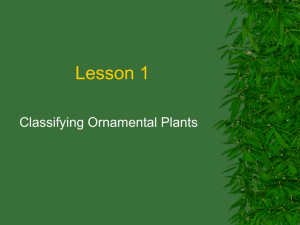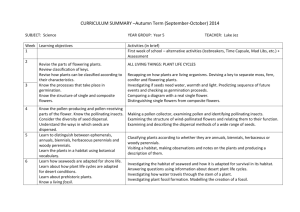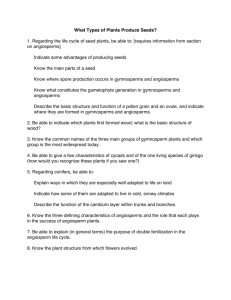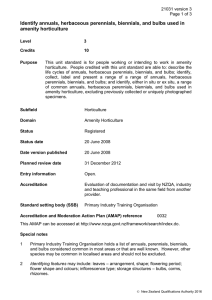Classifying Ornamental Plants
advertisement
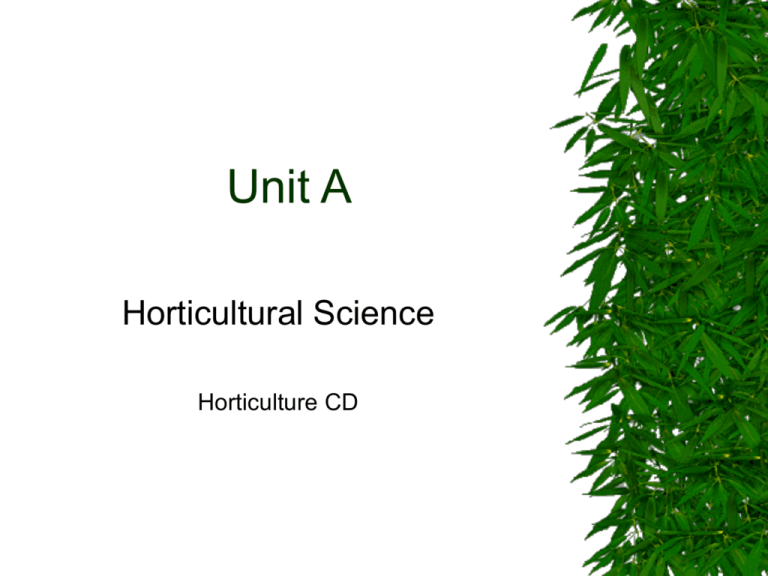
Unit A Horticultural Science Horticulture CD Problem Area 2 Plant Anatomy and Physiology Lesson 1 Classifying Ornamental Plants Interest Approach Suppose you were walking through the woods and stumbled upon an unusual plant. What would you call it? Would you know how to classify it? Could you identify its characteristics? These are questions many taxonomists ponder when labeling a new plant. Interest Approach Cont. Take a couple of minutes and list as many plants as you possibly can. Let’s classify them as deciduous (loose their leaves) or coniferous (remain as evergreens). Now list as many animals as you can. Can you classify them as birds, reptiles, amphibians, insects, fish, or mammals? Why do you know more about animals? Student Learning Objectives 1. Describe the system used for naming and classifying plants 2. Identify the major groups of plants 3. Describe the differences between annuals, biennials and perennials Terms to Know Angiosperm Annuals Biennials Binomial nomenclature Bryophytes Conifer Cotyledons Deciduous Dicots Evergreen Ferns Genus Gymnosperms Herbaceous Monocots Perennials Species Woody How Are Plants Named and Classified? Plants are classified by their similarities within their characteristics. – Taxonomists compare flower patterns, stem and leaf structures, life cycles, genetic similarities and many other characteristics. They are then grouped in specific categories, or taxas: Categories/Taxas Example* Kingdom Plantae Phylum (Division) Class Magnoliophyta Liliopsida Order Cyperales Family Poaceae Genus Species Triticum aestivum *Sample classification of bread wheat Botanists call plants by their last two taxas – genus and species – This system is known as binomial nomenclature (two-word naming system) – Developed by Carolus Linnaeus – Uses Latin for three reasons: Universal (known by all scientists) Very descriptive Unchanged (contains no slang words) – Genus is capitalized; Species lower case Ex. Triticum aestivum What Are Some Ways That We Can Put Plants Into Groups? Plants live in a variety of climates and niches The adaptations that plants have made to survive in different climates allows for them to be classified into one of four major groups: – Bryophytes, ferns, gymnosperms and angiosperms Bryophytes Belong to the phylum Bryophyta Non-vascular plants Liverwort – No conducting tissues Live in damp places Limited in size due to lack of conducting tissue Ex. Mosses and liverworts Moss Courtesy of Wm. C. Brown Publishers Ferns Ferns in the forest Fiddleheads Spores on underside of frond Vascular plants Reproduce by spores Have no true leaves; 0nly fronds Fronds produce food and spores New fronds called fiddleheads Courtesy of Wm. C. Brown Publishers Gymnosperms Reproduce with seeds found in cones Also known as a conifer Leaves reduced to scales or needles Most are evergreen – hold on to their green color year round – Ex. Pines, spruce, cedar Some can be deciduouslose their leaves – Ex. Ginkgo, larch Coniferous evergreen – Pinus contorta Deciduous conifer – Ginkgo biloba Courtesy of Wm. C. Brown Publishers Angiosperms Plants that reproduce by flowers There are two types: monocotyledons (monocots) & dicotyledons (dicots) A cotyledon is a food storage structure in the seed. – Monocots have a single cotyledon Ex. Grasses, corn and lilies – Dicots have two cotyledons Ex. Roses, petunias and geraniums, beans Angiosperms - Monocot Have flower parts (sepals, petals, stamens, pistils) in multiples of three – 3, 6, 9… Orchid – Paphiopedilum curtisii Courtesy of Wm. C. Brown Publishers Parallel venation within the leaves Stems with scattered vascular bundles Narrow leaves Fibrous root system Angiosperms - Dicot Flower parts are in multiples of 4’s or 5’s – 4,12,16 or 5, 10, 15 Netted veins Vascular bundles are in rings around the stem Have broad leaves Taproot system Hibiscus sp. Courtesy of Wm. C. Brown Publishers Monocot vs. Dicot Courtesy of Wm. C. Brown Publishers What Is the Difference Between Annuals, Biennials and Perennials? Plants are often classified based on their life cycles Even though gymnosperms and angiosperms reproduce by seed, there are different strategies for passing the seeds on to future generations Annuals Corn – Zea mays Plants grow from seed, flower, produce new seeds all in one season It dies after producing new seeds Have an herbaceous stem – green & fleshy – Ex. Impatiens, corn, snapdragons See life cycle Courtesy of Wm. C. Brown Publishers Biennials Foxglove – Digitals purpurea Plants that live for two years, then flower and die Food is produced during the first year, flowers the second year – Ex. Foxglove, carrot, queen Anne’s lace See life cycle Courtesy of Wm. C. Brown Publishers Perennials Bristlecone pine – Pinus longaeva Plants that live for three or more years Flower for a short time Do not die after flowering Can be herbaceous or woody – having thick stems made of wood – Ex. Tulips, Kentucky bluegrass, trees and shrubs See life cycle Courtesy of Wm. C. Brown Publishers Back to Annuals Germination----Growth---Flowering----Death Back to Perennials Germination---- Growth---Flowering----Dormancy One or more flowering cycles Back to Biennials Germination---Growth---Dormancy---Growth---Flowering---Death Season 1 Season 2 Courtesy of Interstate Publishing Summary What is the difference between an angiosperm and a gymnosperm? How is a monocot different from a dicot? Are evergreens herbaceous or woody plants? How would you classify the grass found outside on the lawn? Summary Cont. What makes up the scientific name of a plant? Why are scientific names written in Latin? In what group would you find mosses? Describe their habitat. Describe the life cycle of a perennial. Name all 7 taxas in the classification system.
